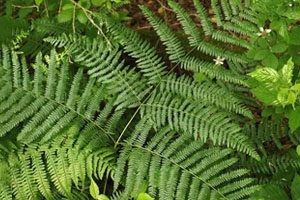Bracken
 Probably the only member of the fern family that most people can readily identify is bracken, simply because it is such a successful coloniser and is so widespread across the country. Bracken, the word originates from Old Norse and is related to the Swedish word “braken” meaning fern, has also been around for some considerable time, with fossil records dating back more than 55 million years.
Probably the only member of the fern family that most people can readily identify is bracken, simply because it is such a successful coloniser and is so widespread across the country. Bracken, the word originates from Old Norse and is related to the Swedish word “braken” meaning fern, has also been around for some considerable time, with fossil records dating back more than 55 million years.
In spring, the new bracken growth pushes up through the ground like mysterious green shepherd’s crooks (called fronds), which on fertile soils can eventually reach over 2 metres (6 feet) in height. Once a frond reaches about 3 or 4 years old it produces unbelievable numbers of spores on the underside of the leaves, numbering several million on each frond. Despite the vast number of spores released, conditions are only really suitable for plant development within woodland and therefore it is not spores that are responsible for the hugely successful spread of this plant, it is the plant’s rhizomes.
Rhizomes are creeping underground roots that can spread the plant a metre or more in a year. Although any particular rhizome only has a lifespan of a few years, individual clones of bracken have been dated back to the Iron Age. For example, researchers wanted to know how big each bracken plant could grow, so they injected a chemical into the plant and then tested the bracken across a hillside. Imagine their surprise when they found the chemical reappearing up to 400 metres (1,300 feet) away, meaning that an individual plant could cover an area of one and a quarter hectares (3 acres), making it one of the world’s largest plants when measured in total biomass.
Bracken has historically been used for a number of purposes such as animal bedding, covering potato clamps, as mulch around garden plants and as a rich source of potash. Indeed there is a company in Cumbria that harvests bracken in July every year when the nutritive value is at its peak and then composts it for four months, before selling it as bagged compost, rich in potash.
Although a fascinating plant, bracken does however cause a number of problems. The plant is carcinogenic if eaten by animals, but they will normally avoid it unless forced to eat it because nothing else is available. People gathering bracken for composting or eradication purposes are advised not to do so in late summer when the spores are released, particularly in dry weather. Once established, bracken can also dominate an area, blocking out light and building up a thick layer of litter, which limits the number of other plant species that can survive. This not only restricts the amount of grass available for sheep to eat, but the leaf litter layer is also an ideal habitat for sheep ticks to inhabit. It can also cause problems on heather moorland, smothering out the much smaller flowering plant.
Land managers used to use a chemical called Asulam to help keep the plant under control, which very specifically killed only bracken, however this product was banned in December 2011, leaving them struggling to keep on top of the plant. As a result, the “bracken control group” was formed, made up of a wide range of people with expertise to consider all control issues and techniques. The GWCT’s Alistair Leake is a member of this panel.
So, bracken has experienced many changes in its 55 million years of inhabiting the earth and does not look to be in any particular hurry to halt its march across the landscape any time yet.
Peter Thompson
Advisory

Download Peter Thompson's essential 26-page book, featuring beautiful photography and detailed profiles of Britain's wildlife
Download FREE >